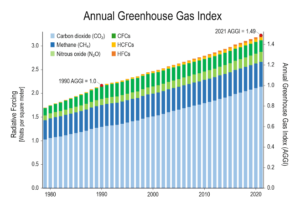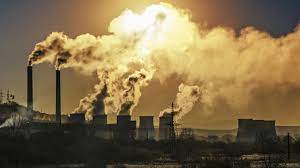Adetokunbo Abiola
Methane continued its upwards emissions spiral, as it recorded its fourth highest annual increase in 2022, rising by 14 parts per billion to 1,911.9 ppb in the past year, faster in 2020 by 15.20 ppb and 17.75 ppb in 2021, with humans having little control over ecosystems that emit methane due to global warming.
Carbon dioxide emissions continued its upwards spiral, as communities around the world emitted more carbon dioxide in 2022 than at any other year on record dating to 1900, rising by 0.9 percent to reach 36.8 gigatons in 2022, with experts saying any year with higher carbon emissions indicate a bad one for humanity and the planet’s health.
Nitrous oxide continued its upwards emissions spiral, as its level rose in 2022 by 1.24 ppb to 335.7 ppb, which is tied with 2014 as the third-largest jump since 2000 and a 24% increase over its pre-industrial level of 270 ppb, the two years of highest growth occurring in 2020 and 2021.

Just when panic arises over the increasing rate of climate change in today’s world, methane, carbon dioxide, and nitrous oxide, the major greenhouse gases responsible for global warming, showed upwards spirals in their emissions in reports recently. Apprehension grows about the ability of humans to tackle climate change, prompting people like the extremely eco-anxious Belgian to sacrifice their life to save the planet.
Methane shows about 80 times the warming capacity of carbon dioxide over the first 20 years after it reaches the atmosphere, with at least 25 percent of today’s global warming driven through the emission of the gas, accounting for around 30 percent of the condition since pre-industrial times and occurring quicker than at any moment since record-keeping began in the 1980s, shooting up during the pandemic-related lockdown of 2020, even as carbon emissions decelerated.
The gas shows an exceptional increase over 2020 and 2021, through a drop in nitrogen oxide emissions, which led to a reduction by 16 percent of hydroxyl concentration in the atmosphere, which in turn hampered the ability of hydroxyl radicals to remove about 85 percent of the methane in the atmosphere.
The gas also shows an exceptional increase in the last two years, because methane emissions from wetlands rose 1.2 to 1.4 million tons per year, faster than the average projections under the most pessimistic scenario that predicted growths of 0.9 tons of methane emissions per year, as long-dormant microbes wake up and release methane into the atmosphere, with the permafrost thawing as the climate warms.
The gas also shows exceptional increases due to the impact of animal agriculture emissions, which grew 17.5 percent between 1990 and 2019. The expansion of the dairy and pork industries led to growth in the sector by 68 percent.
If business continues as usual in the next few years, the exceptional increases in methane emissions could lead to a rise of 11 million tons annually by 2030, with the quantity predicted to reach some 430 million metric tons by 2050, getting to a record high of 1908 parts per billion in 2021, 262 percent above the pre-industrial era levels.
Carbon dioxide measured at NOAAA’s Observatory was recorded for the 11th consecutive year when the gas increased by more than 2 ppm, the highest sustained rate of carbon dioxide increases in the 65 years since monitoring began, with three consecutive years of carbon dioxide growth of 2 ppm or more having never been recorded prior to 2013, the relentless increase of the gas a stark reminder that humanity needs to take urgent steps to become a climate-ready world.
According to IEA reports, global energy-related carbon emissions rose in 2022 by 0.9 percent or 321 million tons, because the gas grew by 1.6 percent or 243 million tons from coal production, exceeding last decade’s average growth rate, and reaching a level of 15.5 gigatons.
Global energy-related carbon dioxide emissions rose last year by around half through air travel, with the level nearing 80 percent of the figure recorded for 2019, even though electric vehicles gained ground in the marketplace, with 10 million cars sold to consumers, contributing over 14 percent of the global purchase of cars.
Global energy-related carbon dioxide emissions jumped through electricity and heat generation, where emissions went up by 1.8 percent or 261 million tons, as emissions of coal-fired electricity and heat generation expanding by 224 million tons or 2.1 percent, figures propelled by developments in Asia.
If business continues as usual in the next few years, air travel, electricity, and coal production could continue to show increases, and by 2030, carbon emissions could get to 16 percent of 2010 levels, putting the world off the track for the 45 percent reduction required to achieve the Paris Agreement’s target of holding global warming to 1.5 degrees Celsius.
Annual global greenhouse gas emissions from carbon dioxide, methane, and nitrous oxide, the three major greenhouse gases, showed increases in 2021, rebounding by 6.4 percent from the previous year to a new record, their highest ever level, eclipsing the pre-pandemic peak through global economic activity resumed.
The major greenhouse gases showed growth through energy-related, wetlands, agriculture, and transportation sectors.
Unless nations undertake solutions such as making the average emissions per person to plummet to 2.5 tons of CO2 by 2030, greenhouse gas emissions could continue to grow, confirming the impression that humans have little control over ecosystems that emit the gases due to global warming





